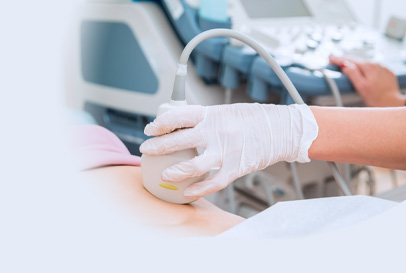Ultrasound
What to know
Ultrasound is a safe and widely used imaging technique producing detailed pictures of the body in real time, using high frequency sound waves which are produced by a special ultrasound probe, called a transducer. Ultrasound has no known harmful effects and can be used to image a variety of conditions including pregnancy, gallstones and varicose veins. Ultrasound can also be used to measure blood flow through vessels, and this is called a doppler or duplex scan.
Do you require an interpreter?
Is the patient non-english speaking? If so, we can arrange for an interpreter to be present during the appointment. Please let us know as soon as possible so we can make the relevant arrangements.
- You will need to make an appointment for this procedure
- Depending on the area of the body to be examined you may be asked to fast from food and fluids before your scan. Alternatively, some procedures require you to drink a significant amount of water prior to arriving so that your bladder is full
- You will be advised of the appropriate preparation when you make your appointment
- Please advise our team members if you require an ultrasound of multiple areas.
- For most ultrasound procedures you will be required to change into a gown and lie on an examination couch
- To obtain optimal images, a layer of warm gel will be applied to the area being imaged so that good contact is made between you and the ultrasound probe
- The probe will be placed directly onto your skin for the duration of the procedure
- Most ultrasound procedures will take between 20 to 30 minutes; however, some studies may require a longer appointment
- Your images will then be reviewed and reported by our specialist radiologists.
Doppler ultrasound uses a special technology that looks at blood flow through the arteries and veins, for example, the carotid arteries in the neck that supply blood to the brain, or the veins of the legs. If you are having this procedure, it is common to hear pulsating noises as the signals coming from flowing blood are converted into sound. Sometimes the sonographer will have to gently squeeze the calf a few times when examining the veins in the legs. This should not be painful.
On occasion, a biopsy, or sample of tissue, may be required by your doctor to diagnose a medical problem. If you are required to have a liver or breast biopsy, the test may need to be performed at a specific branch of Perth Radiological Clinic. Whilst many biopsies have no specific requirements, biopsies of the kidney and liver require special preparation (you will be advised by our customer support team when you make your appointment). The specimen will then be sent to a pathology laboratory for processing and the results will be forwarded to your doctor.
Sometimes your referring doctor may recommend you have a pain-relieving injection into a specific area. A radiologist will perform this procedure and the ultrasound probe is used to guide the injection to the correct place. No specific preparation is required for this procedure.
- Armadale Hospital
- Armadale North
- Bentley Hospital
- Bethesda Hospital
- Booragoon
- Gosnells
- Innaloo
- Hollywood Consulting Centre
- Joondalup – Shenton House
- Joondalup Health Campus
- Midland
- Midland Public Hospital
- Morley
- Mount Medical Centre
- Murdoch – Wexford
- Nollamara
- Rockingham
- South Perth Hospital
- Subiaco





